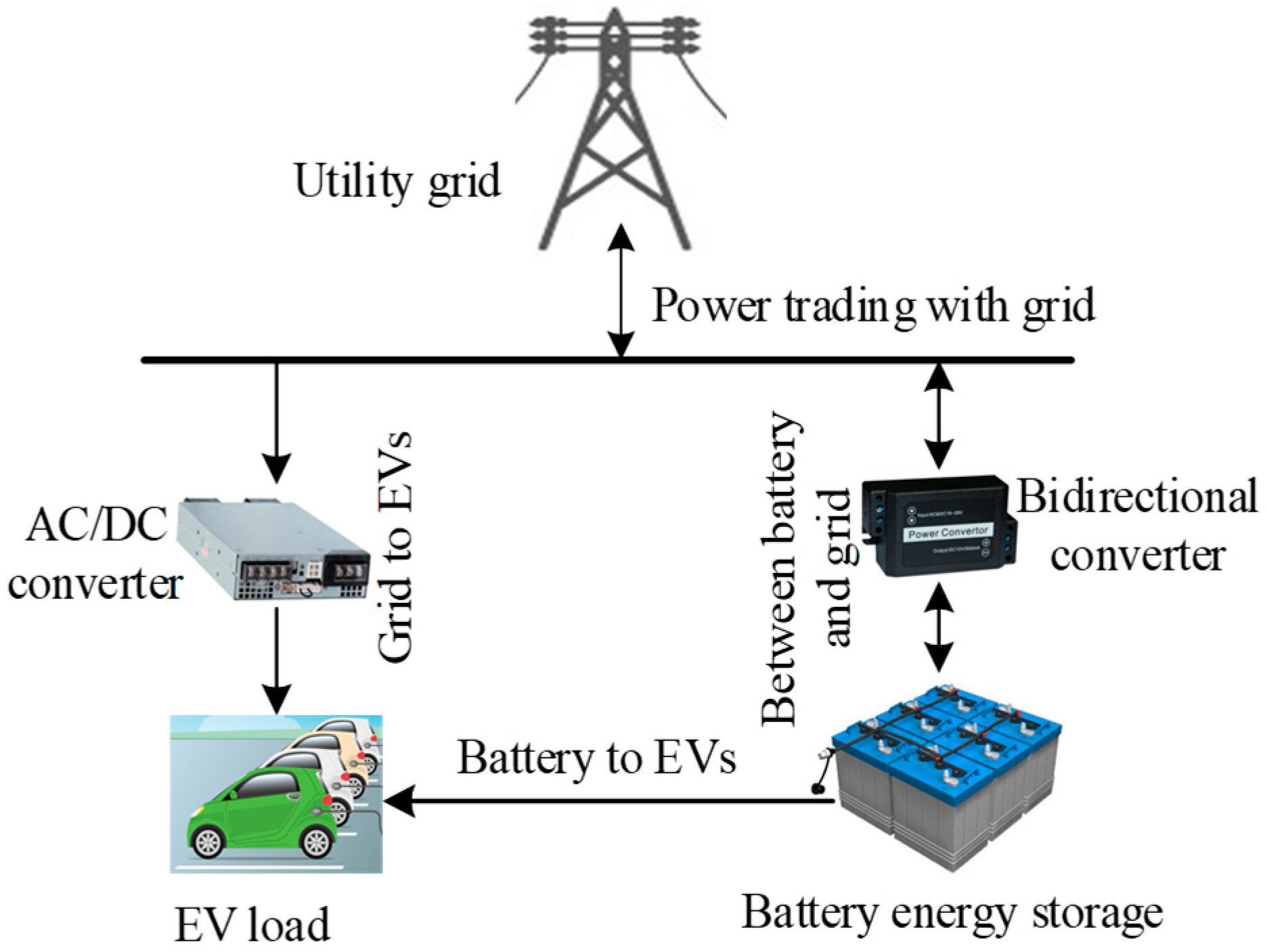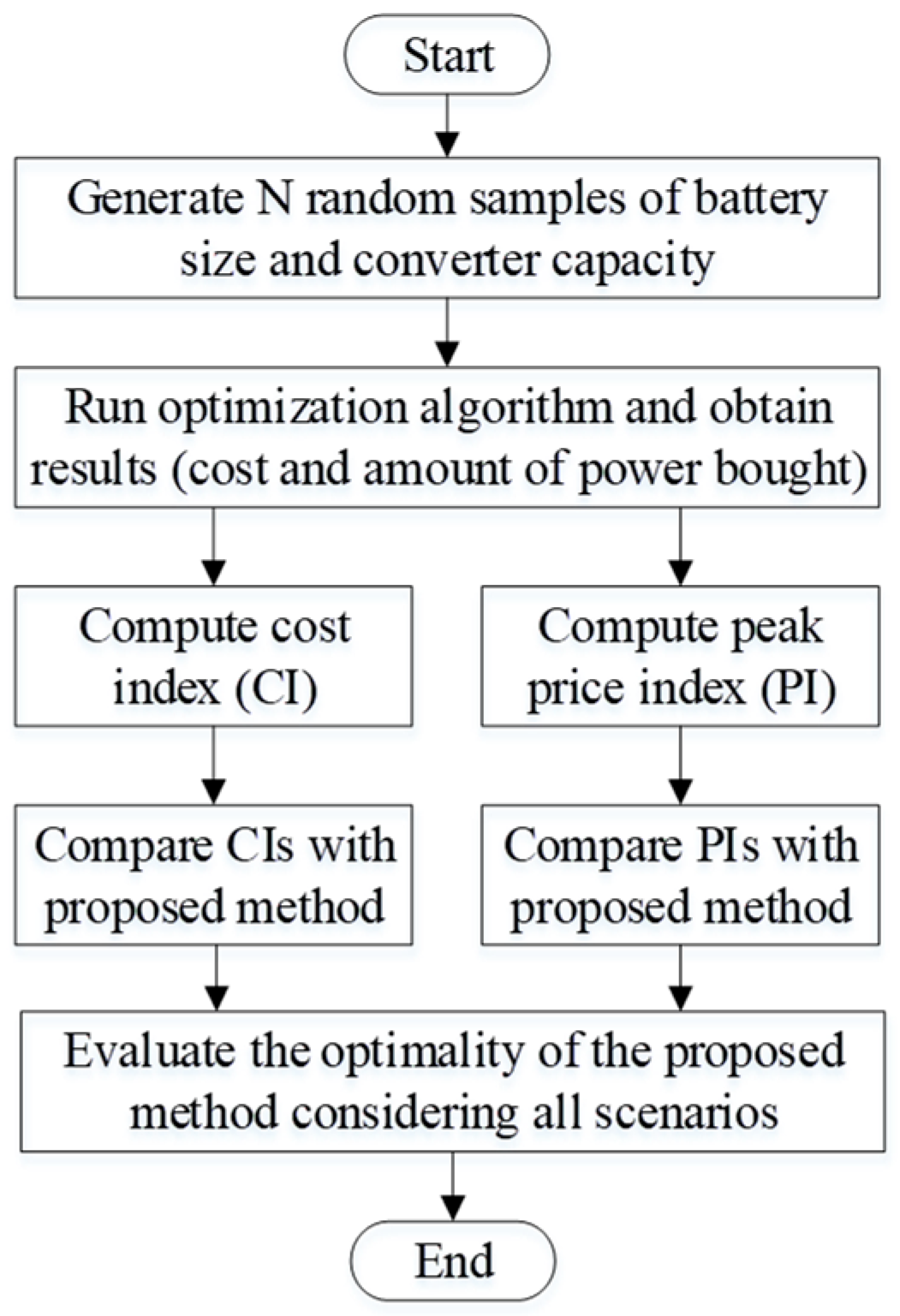Stationary Energy Storage System for Fast EV Charging Stations: Optimality Analysis and Results Validation
Abstract
:1. Introduction
2. Power Balancing in the Network
2.1. Network Configuration
2.2. Electric Vehicle (EV) Load
2.3. Energy Storage System (ESS)
2.4. Utility Grid
2.5. Power Conversion System (PCS)
3. Optimality Evaluation Indices
3.1. Cost Index
3.2. Power Index
4. Mathematical Modeling for Results Evaluation
4.1. Objective Function
4.2. Power Balancing Constraints
4.3. ESS and Converter Constraints
5. Simulation Results: Optimality Analysis
5.1. Input Data
5.2. Power Index Evaluation
5.3. Cost Index Evaluation
6. Simulations Results: Results Verification
6.1. Input Data
6.2. Winter Season
6.3. Spring Season
6.4. Summer Season
6.5. Autumn Season
6.6. Representative National Holidays
6.7. Comparison of Different Cases
7. Conclusions
Author Contributions
Funding
Acknowledgments
Conflicts of Interest
Nomenclature
| Identifiers and Binary Variable | |
| The identifier for a day, running from 1 to D. | |
| The identifier for a time interval, running from 1 to T (hour). | |
| , | Identifiers for daily peak beginning and peak ending time intervals (hour). |
| An identifier for the number of scenarios, running from 1 to S. | |
| Binary variables for buying and selling power, respectively. | |
| Binary variables for charging and discharging power to/from ESS, respectively. | |
| Parameters and Variable | |
| The yearly cost of charging station without ESS (KRW). | |
| The yearly cost of charging stations for scenario s and optimal cases, respectively (KRW). | |
| Cost ratio for scenario s (KRW). | |
| , | Cost index for scenario s and normalized cost index, respectively. |
| Amount of power bought for scenario s and optimal case, respectively (kWh). | |
| Yearly investment cost of ESS for scenario s and optimal case, respectively (KRW). | |
| , | Power ratio and investment cost ratio for scenario s. |
| , | Power index for scenario s and normalized cost index, respectively. |
| The power demand for fast EV charging stations at time t (kW). | |
| , | Cost for trading power and for buying power during peak period, respectively (KRW). |
| , | Cost of ESS (KRW) and penalty price for buying power from the grid during peak intervals (KRW/kWh), respectively. |
| Price for buying and selling power during day d and time t, respectively (KRW/kWh). | |
| Amount of power bought and sold during day d and time t, respectively (kW). | |
| , | Cost recovery factor for converter and battery, respectively. |
| , | The capacity of the converter (kW) and size of the battery (kWh), respectively. |
| , | Cost of PCS and yearly operation & maintenance cost of the battery, respectively (KRW). |
| Cost of battery and balance of plant, respectively (KRW). | |
| , | Amount of power charged and discharged to/from the battery at t, respectively (kW). |
| Maximum and minimum operation range of SOC, respectively (%). | |
| , | Charging efficiency and discharging efficiency of the battery, respectively (%). |
| Initial SOC of battery at the beginning of the day (kWh). | |
References
- Zaira, N.A.; Diego, G.G.; Diego, I. Prospective life cycle assessment of the increased electricity demand associated with the penetration of electric vehicles in Spain. Energies 2018, 11, 1185. [Google Scholar]
- Ricardo, G.L.; Jose, M.M.D. Renewable Energies and CO2, 2012th ed.; Springer: Berlin/Heidelberg, Germany, 2012; pp. 9–31. [Google Scholar]
- IEA. Energy, Climate Change and Environment: 2016 Insights; International Energy Agency: Paris, France, 2016. [Google Scholar]
- Nie, Y.; Chung, C.Y.; Xu, N.Z. System state estimation considering EV penetration with unknown behavior using quasi-Newton method. IEEE Trans. Power Syst. 2016, 31, 4605–4615. [Google Scholar] [CrossRef]
- Sharma, H.; Rylander, M.; Dorr, D. Grid Impacts Due to Increased Penetration of Newer Harmonic Sources. In Proceedings of the IEEE Rural Electric Power Conference (REPC), Stone Mountain, GA, USA, 28 April–1 May 2013; p. B5-1. [Google Scholar]
- Farhoodnea, M.; Mohamed, A.; Shareef, H.; Zayandehroodi, H. Power quality impacts of high-penetration electric vehicle stations and renewable energy-based generators on power distribution systems. Measurement 2016, 46, 2423–2434. [Google Scholar] [CrossRef]
- Ding, H.; Hu, Z.; Song, Y. Value of the energy storage system in an electric bus fast charging station. Appl. Energy 2015, 157, 630–639. [Google Scholar] [CrossRef]
- Bao, Y.; Luo, Y.; Zhang, W.; Huang, M.; Wang, L.; Jiang, J. A Bi-Level optimization approach to charging load regulation of electric vehicle fast charging stations based on a battery energy storage system. Energies 2018, 11, 229. [Google Scholar] [CrossRef] [Green Version]
- Ehsan, A.; Yang, Q. Active distribution system reinforcement planning with EV charging stations-Part I: Uncertainty modelling and problem formulation. IEEE Trans. Sustain. Energy 2019. [Google Scholar] [CrossRef]
- Sbordone, D.; Bertini, I.; Di, P.B.; Falvo, M.C.; Genovese, A.; Martirano, L. EV fast charging stations and energy storage technologies: A real implementation in the smart micro grid paradigm. Electr. Power Syst. Res. 2015, 120, 96–108. [Google Scholar] [CrossRef]
- Bryden, T.S.; Hilton, G.; Dimitrov, B.; de León, C.P.; Cruden, A. Rating a stationary energy storage system within a fast electric vehicle charging station considering user waiting times. IEEE Trans. Transp. Electrif. 2019. [Google Scholar] [CrossRef] [Green Version]
- Ligen, Y.; Vrubel, H.; Girault, H. Local energy storage and stochastic modeling for ultrafast charging stations. Energies 2019, 12, 1986. [Google Scholar] [CrossRef] [Green Version]
- Yan, Y.; Wang, H.; Jiang, J.; Zhang, W.; Bao, Y.; Huang, M. Research on configuration methods of battery energy storage system for pure electric bus fast charging station. Energies 2019, 12, 558. [Google Scholar] [CrossRef] [Green Version]
- Longo, L. Optimal Design of an EV Fast Charging Station Coupled with Storage in Stockholm. Master’s Thesis, KTH School of Industrial Engineering and Management, Brinellvägen, Stockholm, 2017. Available online: https://pdfs.semanticscholar.org/b24f/6b1b8a3c18eaba18cd401f326cec2d6c718e.pdf (accessed on 1 January 2020).
- Negarestani, S.; Fotuhi-Firuzabad, M.; Rastegar, M.; Rajabi-Ghahnavieh, A. Optimal sizing of storage system in a fast charging station for plug-in hybrid electric vehicles. IEEE Trans. Transp. Electrif. 2016, 2, 443–453. [Google Scholar] [CrossRef]
- Hussain, A.; Bui, V.H.; Baek, J.W.; Kim, H.M. Stationary energy storage system for fast EV charging stations: Simulations sizing of battery and converter. Energies 2019, 12, 4516. [Google Scholar] [CrossRef] [Green Version]
- Choi, J.; Lee, W.D.; Park, W.H.; Kim, C.; Choi, K.; Joh, C.H. Analyzing changes in travel behavior in time and space using household travel surveys in Seoul metropolitan area over eight years. Travel Behav. Soc. 2014, 1, 3–14. [Google Scholar] [CrossRef]
- Qian, K.; Zhou, C.; Allan, M.; Yuan, Y. Modeling of load demand due to EV battery charging in distribution systems. IEEE Trans. Power Syst. 2010, 26, 802–810. [Google Scholar] [CrossRef]
- Zhang, P.; Qian, K.; Zhou, C.; Stewart, B.G.; Hepburn, D.M. A methodology for optimization of power systems demand due to electric vehicle charging load. IEEE Trans. Power Syst. 2012, 27, 1628–1636. [Google Scholar] [CrossRef]
- Parisio, A.; Rikos, E.; Glielmo, L. A model predictive control approach to microgrid operation optimization. IEEE Trans. Control Syst. Technol. 2014, 22, 1813–1827. [Google Scholar] [CrossRef]
- Carli, R.; Dotoli, M. Decentralized control for residential energy management of a smart users’ microgrid with renewable energy exchange. IEEE/CAA J. Autom. Sin. 2019, 6, 641–656. [Google Scholar] [CrossRef]
- Hussain, A.; Bui, V.H.; Kim, H.M. Impact analysis of demand response intensity and energy storage size on operation of networked microgrids. Energies 2017, 10, 882. [Google Scholar] [CrossRef] [Green Version]
- Carli, R.; Dotoli, M. Energy Scheduling of a Smart Home under Nonlinear Pricing. In Proceedings of the 53rd IEEE Conference on Decision and Control, Los Angeles, CA, USA, 15–17 December 2014; pp. 5648–5653. [Google Scholar]
- Carli, R.; Dotoli, M. Cooperative Distributed Control for the Energy Scheduling of Smart Homes with Shared Energy Storage and Renewable Energy Source. IFAC-PapersOnLine 2017, 50, 8867–8872. [Google Scholar] [CrossRef]
- Apache NetBeans. Available online: https://netbeans.org/ (accessed on 1 January 2020).
- IBM. ILOG CPLEX V12.6 User’s Manual for CPLEX 2015, CPLEX Division; ILOG: Incline Village, NV, USA, 2015. [Google Scholar]
- Traditional Korean Holiday of Bountiful Harvest, Chuseok. Available online: https://english.visitkorea.or.kr/enu/ATR/SI_EN_3_6.jsp?cid=811650 (accessed on 1 January 2020).
- Celebrating Seollal in Korea: A Glimpse of Local Customs. Available online: https://english.visitkorea.or.kr/enu/ATR/SI_EN_3_6.jsp?cid=941952 (accessed on 1 January 2020).
- Hosseini, S.M.; Carli, R.; Dotoli, M. Model Predictive Control for Real-Time Residential Energy Scheduling under Uncertainties. In Proceedings of the IEEE International Conference on Systems, Man, and Cybernetics (SMC), Miyazaki, Japan, 7–10 October 2018; pp. 1386–1391. [Google Scholar]
- Touretzky, C.R.; Baldea, M. Integrating scheduling and control for economic MPC of buildings with energy storage. J. Process Control 2014, 24, 1292–1300. [Google Scholar] [CrossRef]















| Scenarios | Total Cost Index | Investment Cost Index | Peak Power Index | |||
|---|---|---|---|---|---|---|
| Maximum | Minimum | Maximum | Minimum | Maximum | Minimum | |
| 1–100 | 0.938911 | −0.94318 | 1 | −17.3996 | 0.938911 | −0.94318 |
| 101–200 | 0.945434 | −1.05896 | 1 | −17.422 | 0.846379 | −0.96941 |
| 201–300 | 0.948319 | −0.84696 | 1 | −17.4505 | 0.855825 | −0.97841 |
| 301–400 | 0.950075 | −0.74837 | 1 | −17.419 | 0.856725 | −0.91341 |
| 401–500 | 0.948695 | −0.52358 | 1 | −17.4310 | 0.848403 | −0.97413 |
| 501–600 | 0.947316 | −0.96500 | 1 | −17.4378 | 0.840306 | −0.97593 |
| 601–700 | 0.951831 | −0.65404 | 1 | −17.0082 | 0.869996 | −0.97526 |
| 701–800 | 0.948946 | −0.71287 | 1 | −17.0412 | 0.867746 | −0.91588 |
| 801–900 | 0.951706 | −0.85499 | 1 | −17.4145 | 0.873594 | −0.97706 |
| 901–1000 | 0.946688 | −0.96851 | 1 | −16.9573 | 0.864148 | −0.95119 |
| Total | 0.951831 | −1.05896 | 1 | −17.4505 | 0.938911 | −0.97841 |
| Time of Year | Day Type | Energy Bought during Peak Price Intervals (kWh) | ESS Utilized during off-Peak Intervals (kWh) |
|---|---|---|---|
| Winter season | Working day | 0 | 0 |
| Holiday | 0 | 0 | |
| Spring season | Working day | 0 | 0 |
| Holiday | 0 | 0 | |
| Summer season | Working day | 0 | 0 |
| Holiday | 0 | 95.89 | |
| Autumn season | Working day | 158.31 | 0 |
| Holiday | 0 | 0 | |
| Public holidays | Holiday (September) | 0 | 51.14 |
| Holiday (February) | 0 | 82.94 |
© 2020 by the authors. Licensee MDPI, Basel, Switzerland. This article is an open access article distributed under the terms and conditions of the Creative Commons Attribution (CC BY) license (http://creativecommons.org/licenses/by/4.0/).
Share and Cite
Hussain, A.; Bui, V.-H.; Baek, J.-W.; Kim, H.-M. Stationary Energy Storage System for Fast EV Charging Stations: Optimality Analysis and Results Validation. Energies 2020, 13, 230. https://doi.org/10.3390/en13010230
Hussain A, Bui V-H, Baek J-W, Kim H-M. Stationary Energy Storage System for Fast EV Charging Stations: Optimality Analysis and Results Validation. Energies. 2020; 13(1):230. https://doi.org/10.3390/en13010230
Chicago/Turabian StyleHussain, Akhtar, Van-Hai Bui, Ju-Won Baek, and Hak-Man Kim. 2020. "Stationary Energy Storage System for Fast EV Charging Stations: Optimality Analysis and Results Validation" Energies 13, no. 1: 230. https://doi.org/10.3390/en13010230
APA StyleHussain, A., Bui, V. -H., Baek, J. -W., & Kim, H. -M. (2020). Stationary Energy Storage System for Fast EV Charging Stations: Optimality Analysis and Results Validation. Energies, 13(1), 230. https://doi.org/10.3390/en13010230







